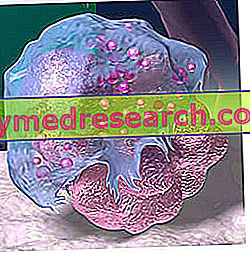Macrophages are highly differentiated immune cells in various tissues of the body, where they play the role of "scavengers of the human body". Macrophages concentrate where there is a need to eliminate a waste, such as a beating, a tissue breakdown product or a damaged cell.

During its existence, a macrophage can eliminate more than 100 bacteria, but if necessary it can also remove larger particles from the tissues, such as aged red blood cells or necrotic neutrophils (neutrophils are another type of white blood cells with phage activity)., therefore similar to that of macrophages, but they are smaller and much more numerous, and they act above all on a blood level). In general, macrophages absorb and digest antigens, or whatever is foreign to the organism or is recognized as such, therefore worthy of attack and neutralization. Once the antigens have been digested, the macrophages process some components exposing them on their outer membrane linked to surface receptors (MHC proteins, called "major histocompatibility complex"). These complexes, which are very important for the immune function, act as special "antennae" or "identifying flags" that signal the danger to other immune cells, requiring reinforcements. When they cover this function, macrophages are called antigen-presenting cells ( Antigen-Presenting Cell ).
In addition to presenting antigen to lymphocytes, macrophages produce and secrete a wide range of secretion products (such as some interleukins or TNF-alpha tumor necrosis factor), which allow communication between the various types of lymphocytes; they are therefore able to influence the migration and activation of other cells of the immune system.

After the pathogen has been transformed into macrophage food, these cells bind it, surround it and incorporate it, confining it to vesicles called phagosomes. Inside the macrophage, phagosomes merge with lysosomes, vesicles rich in digestive enzymes and oxidizing agents, such as acid hydrolases and hydrogen peroxide, which kill and demolish what is incorporated. Thus phagolysosomes are formed, otherwise known as "chambers of death".
In addition to large lysosomes, macrophages are markedly larger than the other leukocytes, the Golgi apparatus and the particularly developed nucleus, and the richness of acto-myosin filaments, which give the macrophage a certain motility (migration at infection sites).



